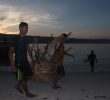DAVAO CITY — Jolito Divinagracia, 34, and Ranel Enoc, 30, are among the farmers in Tamugan, Calinan district here, whose parents are beneficiaries of the government’s Comprehensive Agrarian Reform Program (CARP).
But almost 20 years into the program, both their families are still having a hard time acquiring the land supposedly awarded to them by CARP.
“Our income is very small,” Ranel told davaotoday in a recent farmers’ picket at Rizal Park. “That is why we’re having a hard time paying for the amortization. Our income varies every month, mainly from the sale of crops and fruits we grow. We have to set a budget merely for the payment of the land.”
CARP, a government land reform program started in 1988, is supposed to distribute land to agrarian reform beneficiaries. It requires farmers’ amortization for the acquisition of lands formerly owned by private landowners.

Still Landless. Celso Pojas, spokesperson for Kilusang Magbubukid ng Pilipinas (KMP) Southern Mindanao. (davaotoday.com photo by Barry Ohaylan)
The Department of Agrarian Reform, the government agency that implements CARP, has set guidelines on how to make the payments affordable.
It takes only up to five percent of the value of the land’s annual gross production (as established by DAR) for the first five annual amortization payment.
After five years, the Land Bank of the Philippines (LBP) may reduce the interest rate or the principal obligation when the scheduled annual payment exceeded 10 per cent of the annual gross production and the failure to produce is not due to the beneficiary’s fault.
This policy is supposed to lighten the farmers’ amortization payment. But the rising cost of inflation and the increase in the cost of living in recent years have been eating up a big chunk of the farmer’s income, making it hard for most of them to pay for the amortization to finally acquire the land.
From the small parcel of land planted with bananas, coconuts and other fruit-bearing trees, for instance, Jolito�s family only earn a meager P3,000 to P5,000 during harvestime, which occurs once in every three months.
“We have to put food on the table first,” Jolito said, “So, there are times when we can’t pay the amortization.”
He said his family is constantly hounded by fear that the bank would foreclose the property and confiscate their land, if they fail to pay the amortization on time.
Rodolfo T. Inson, DAR XI regional director, said Jolito’s dilemma reflects the dilemma of many agrarian reform beneficiaries, who are having a hard time paying the amortization. Some of these beneficiaries have forfeited the land.
Inson said that of the total land area distributed for land reform in the region, 60 per cent are private agricultural lands, and only 40 per cent are public ones. Which means that the government is buying more land from the private sector; and that, more farmers are paying rather than acquiring lands for free.
Land Reform









